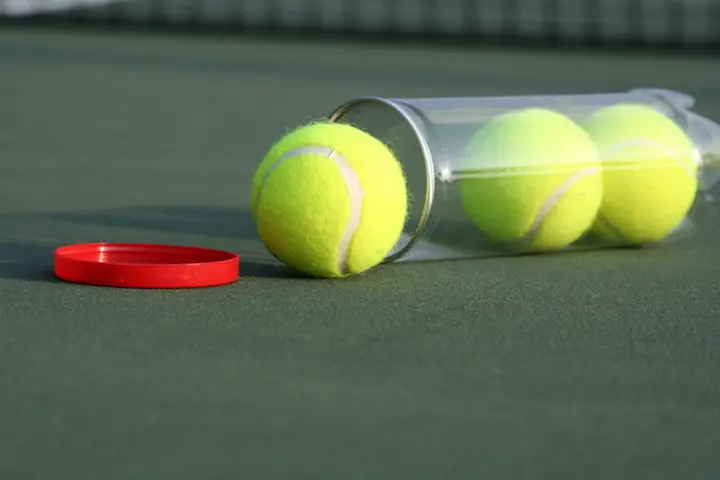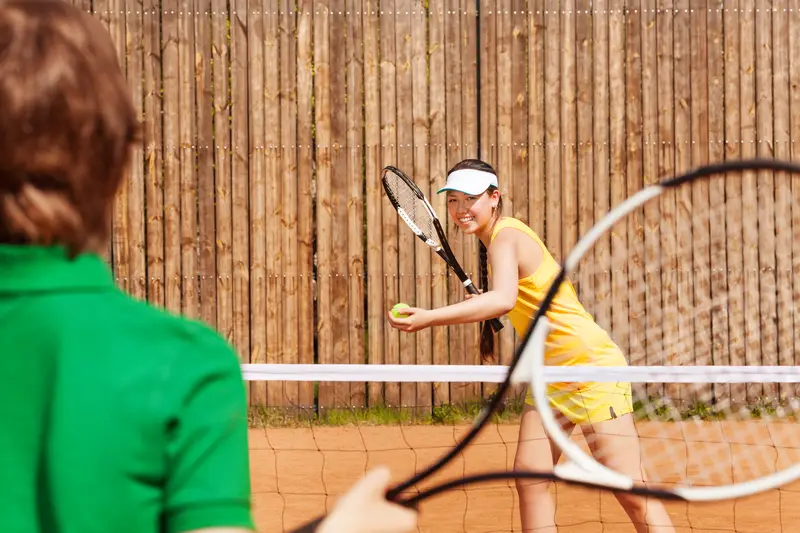Your Guide
 Gavin Davison
Gavin Davison
Have you ever stopped to wonder whether all tennis balls were created equally?
And by equally, I mean whether they have been created to fit a particular size or not?

If so, I can inform you now that all regular tennis balls are manufactured to suit a particular size – as determined by the International Tennis Federation.
This governing body actually has a list of approved tennis balls on its website, although as for the particular size, it is agreed upon that approved tennis balls must have a diameter of 2.57 to 2.70 inches.
This provides a very small and precise size that all tennis balls must conform to, which helps to keep things standardized across the board.
Sure, we could argue that the sizes of regular tennis balls may differ slightly, but it will be so negligible that the difference will barely be noticeable – unless you got your tape measure out, of course!
But let’s be honest, who’s going to check up on such minor details?
I can, however, tell you that there are various types of tennis balls you may want to consider using depending on what stage you are at in your game.
Rather than purely stick with regular tennis balls I’ve decided to run through all of the various types to help those with kids who may also be learning the game. I’ve detailed all of this below.
The Various Types of Tennis Balls and Their Differences
Back when I started playing, I can recall that there were two options for tennis balls.
You either played with sponge balls or you played with regular balls. There was no in-between, so when making the transition, you either had to adapt or you wouldn’t get better with tennis.
Luckily, these days there are many different balls to help kids and even adults who are just starting to learn the game make that transition.
Not only is this better in terms of overall development, but it’s more fun to learn this way too.
So, with that said, here are the various tennis balls that people progress through when learning the game of tennis.
Sponge Ball
If you’re an adult, sure, you’re not going to START OUT WITH sponge balls.
Although with that said, a game that has rapidly gained popularity, touch tennis, has started to use a similar ball for adult tournaments.
These balls are obviously much lighter than their distant tennis ball cousins, and they allow you to get rallies going without having to put tons of force into your shots.
Again, I’m not recommending that adults go out and practice with sponge balls, I’m merely demonstrating the differences here.
As for the size, sponge tennis balls can be around 8cm – 9cm (3.15 – 3.54 inches) in diameter, compared with the smaller regular tennis balls.
Of course, they are also made of foam, which makes them lightweight and easy to play with.
Red Ball
One step up from the sponge tennis ball and we have red balls.
Typically, these are used by small children who are too big really to play with sponge balls.
The balls are heavier than sponge balls, they are large, and thanks to the reduced pressure in the ball, they don’t bounce as high as the other tennis balls I’ll shortly be talking about.
The whole reason behind these specifications is to help small kids learn to hit the ball the right way without dealing with vibrant and high-bouncing balls that are then too difficult to play with.
Naturally, this makes things more fun for the kids if they are able to rally too!
As I stated above, these balls are still pretty large, with an accepted diameter being anywhere from 7cm – 8cm (2.76 – 3.15 inches).
Orange Ball
After progressing through the red ball stage of the game, young children can then get started with orange balls.
Keeping in line with the progression expectations here, these balls are then slightly more pressurized than red balls so that they bounce higher, they are larger, and their category is actually indicated by the orange coloring on the ball.
These balls cannot be used from the back of the court, however, as there isn’t enough juice in them to be perfectly honest.
Instead, orange ball tennis is played on a three-quarter court, and the ball size is actually 6cm – 6.86cm in diameter (2.36 – 2.70 inches).
This is also the stage in which kids can start to think about playing with larger tennis rackets to accompany the increased difficulty in the tennis ball itself.
Green ball
Green tennis balls are the final step in the journey before progressing to regular tennis balls, and these can be used on a full court.
The size of these tennis balls is actually not too different from orange balls, and the typical diameter is 6.30cm – 6.86cm (2.48 – 2.70 inches).
In fact, it’s only really the pressure of these balls that make them more similar to a regular ball compared with orange balls.
As I said, they can be used on a full-court, and if you are a beginner as an adult, sometimes the coach may ask you to use these balls just to work on smaller technical aspects.
Please note that there is nothing wrong with this, it’s purely to help you further down the line before using regular tennis balls from the baseline.
Which Tennis Balls Should You Actually Get?
Assuming you want to go ahead and play with regular tennis balls, there are plenty of options in the market today.
For me, I am a big fan of the Babolat Team, Wilson US Open, and Robin Soderling tennis balls.
These vary somewhat in terms of how they react off the strings and how they respond with the court surface, so you may want to trial them down at your local club before you go ahead and purchase any.
Of course, you don’t have to stick with these recommendations, and there is certainly no shortage of tennis balls you can choose from these days.
In fact, you can check out specifics on all tennis balls right here!
Whichever tennis balls you ultimately decide to play with, whether regular or green to adapt your form, I wish you all the best with enjoying the game and honing your skills.
Did you enjoy this article? Feeling more confident with what tennis balls are used for what reasons? Let us know your key takeaways in the comments!





